Consumer and Producer Perceptions and Preferences for Pollinator-Friendly Labeling Practices in the US Green Industry
Introduction
Recent pollinator population declines have led to in-depth investigations of the causes behind decreased insect pollinator health and diversity (Goulson 2013; van de Sluijs 2013). Neonicotinoid pesticides have been identified as a potential contributing factor (van de Sluijs 2013; Sanchez-Bayo and Goka 2014; Goulson et al. 2015; Pisa et al. 2015). As a result, neonicotinoids have been banned in several European countries. In the United States, large home and garden retailers now require plants produced using neonicotinoids to be labeled. To date, labeling of the presence or absence of neonicotinoids is voluntary. Consumer and producer reactions to these labels have not been examined and thus are unknown. Given consumer awareness of neonicotinoids is still low (Wollaeger et al. 2015; Rihn and Khachatryan 2016), labeling neonicotinoids may have minimal effects on consumer demand for neonicotinoid-free products. However, increasing consumer interest in sustainable products suggests that labeling neonicotinoids may reduce demand for plants grown using neonicotinoids due to environmental concerns (Khachatryan et al. 2014; Khachatryan et al. 2017; Yue et al. 2010; Yue et al. 2016). Socially optimal labeling policies, profit maximizing production, and adoption of alternative pest-management practices in the Green Industry hinge in part on the value consumers place on neonicotinoid-free products. It is therefore critical to understand the feedback from both consumers and producers. The current study summarizes consumer and producer perceptions about neonicotinoid-related regulations and labeling practices and identifies discrepancies between consumer and producer preferences for different pollinator-friendly labeling phrases.
Method
Parallel studies were conducted to understand the perceptions and preferences for pollinator-friendly labeling practices from both the consumers' and producers' perspectives. To reach the maximum sample coverage, the consumer survey was administered by recruiting both a local (Florida) and online national sample. Local participants were required to be physically present to fill out the survey in person in our experimental facility. The producer survey was distributed through online trade magazine website and mail avenues.
Respondents to the consumer survey answered questions about their plant-purchasing behaviors, sociodemographics, and knowledge and perceptions about neonicotinoids and pollinator-friendly labeling practices. The producer survey, on the other hand, collected information about individual growers' production characteristics, current use of neonicotinoid and non-neonicotinoid insecticides, and their perceptions about neonicotinoids and labeling practices.
Three questions included in both consumer and producer surveys were cross-compared and analyzed to determine the different viewpoints of consumers and producers. The first question provided a list of labels with different wording options (e.g., pollinator attractive, bee safe, etc.) indicating that a plant was produced in a way that is safe for pollinator insects. Survey respondents were then asked to select the three labels most attractive to consumers. In the second question, survey respondents selected their level of agreement or disagreement on a 7-point Likert scale with the following two statements regarding neonicotinoid pesticides and pollinators.
The last question asked survey respondents to indicate on a 1–7 rating scale (1 indicating strongly disagree, 4 neither agree nor disagree and 7 strongly agree) whether labeling the use of neonicotinoids should be mandatory.
Results
Consumer perceptions: 141 participants were recruited from central Florida and 420 participants were recruited nationwide for the consumer survey. (The national online sample also contains some Floridian participants, but those participants are different from the local sample.) Even though survey respondents were from two different populations (Florida and national), sample representativeness was ensured because our statistics in both samples are close to the national level of public knowledge about neonicotinoids (Rihn and Khachatryan 2016; Wollaeger et al. 2015). Additionally, the two samples were very consistent in their perceptions and preferences for labeling. Consumers from both samples agreed that the top three most attractive labeling phrases indicating pollinator-friendly production were "Pollinator friendly," "Pollinator attractive," and "Plants for pollinators." The least preferred labeling phrase was "Neonic-free" (Figure 1). Breaking down the labeling phrases into key words, we identified that "pollinator" and "bee" are the most attractive key words. Consumers preferred using "friendly" and "attractive" more than the word "safe." Consumers did not find logos/images an appealing format.
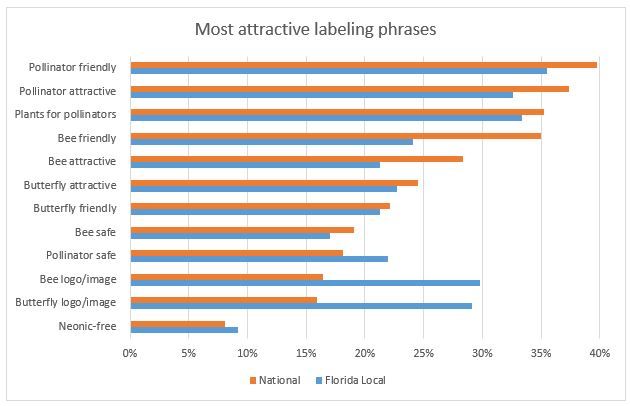
Regarding consumers' agreement with statements related to pollinator labeling, the mean rating for the statement pertaining to the effectiveness of neonicotinoid pesticides was 4.2 for the national sample and 4.5 for the Florida local sample. About 38% of the national sample and 42% of the Florida sample agreed that neonicotinoid pesticides are effective tools to protect plants by selecting 5 or more on the rating scale (Figure 2.1). On the other hand, as shown in Figure 2.2, the majority of the consumer survey respondents (75% of the national survey respondents and 55% of the Florida local sample) indicated their concerns about the effects of neonicotinoids on pollinators. The mean rating score for the national and Florida survey respondents was 5.5 and 4.9, respectively.
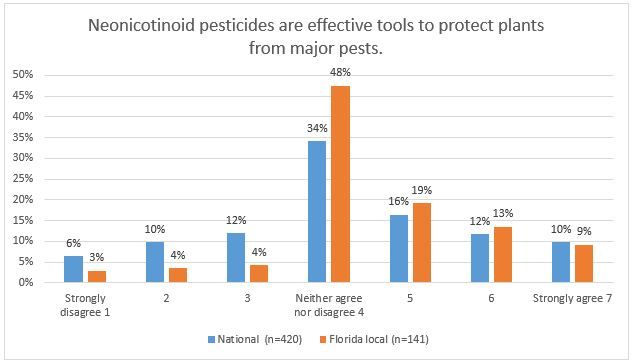
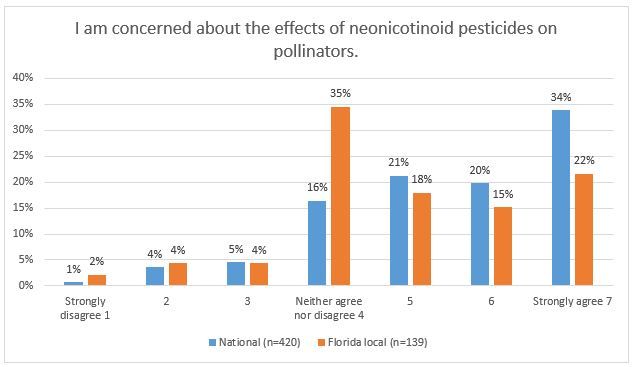
Regarding perceptions about whether labeling neonicotinoids should be mandatory or voluntary, 87% of the online national sample and 75% of the Florida local sample agreed that labeling of neonicotinoids should be mandatory (Figure 3).
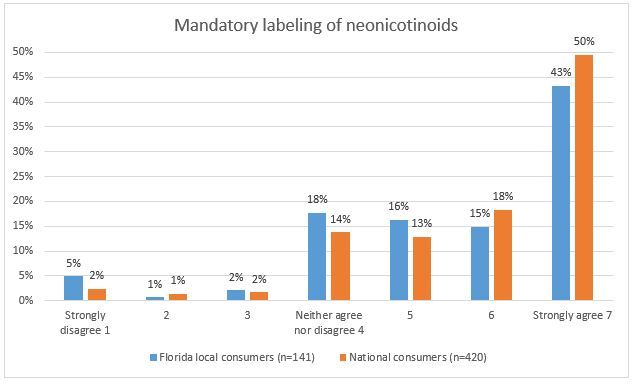
Producer perceptions: Links to the online producer survey were first promoted through different trade magazine websites (e.g., Nursery Management, Greenhouse Grower, etc.) between August 2018 and December 2018. 3000 mail surveys were then sent out in a second wave of data collection in March 2019. Combining both online and mail survey responses, there were a total of 354 producers who completed the producer survey with 95 online responses and 259 mail responses (for a 9% response rate in the mail survey). Even though the producer survey targeted the standard Green Industry producers, a large number of small hobby growers (e.g., one-person operations, single-household operations) were self-selected to participate in the mail survey. The producer respondents were therefore split into two groups based on the number of employees (including both permanent and temporary) to differentiate the small hobby growers (with fewer than five employees) from the standard Green Industry producers (with five or more employees). Out of the total 354 responses, 188 were classified as small hobby growers and 166 were standard Green Industry producers. Regardless of firm size, both small hobby growers and standard Green Industry producers agreed that "Pollinator friendly," "Pollinator safe," and "Bee friendly" are the three labeling phrases most attractive to consumers (Figure 4). While consumers believed "Neonic-free" is the least appealing, producers voted that "Bee attractive" was the least appealing. For individual key words in the labels, both small hobby growers and industry standard growers preferred "friendly" and "safe" more than the word "attractive." Consistent with consumer perceptions, "pollinator" was also found to be most preferred by producer respondents, followed by "bee" and "butterfly." Parallel to consumer perceptions, there also was no evidence that producers preferred logos/images.
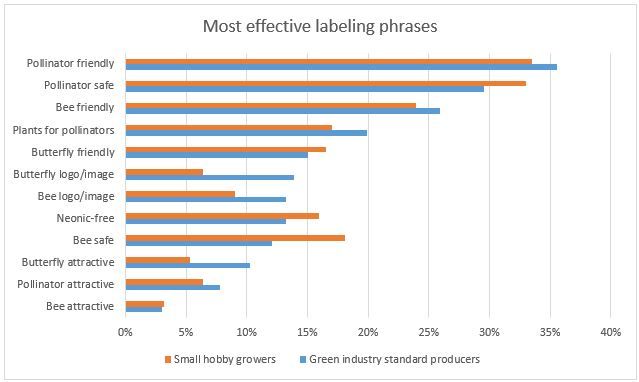
Regarding producer perceptions about the two statements concerning the effects of neonicotinoid pesticides, slightly different viewpoints were observed between the two groups. While 40% of the small hobby growers selected the "neither agree nor disagree" option, more than half of the Green Industry standard producers expressed their strong agreement with the effectiveness of neonicotinoids in protecting their crops (Figure 5.1). On the other hand, 52% of the small hobby growers showed strong concerns about the effects of neonicotinoids on pollinators (Figure 5.2).
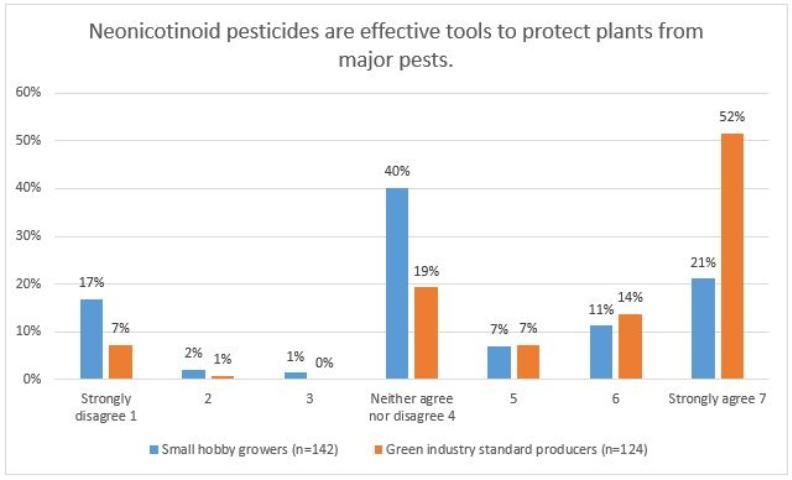
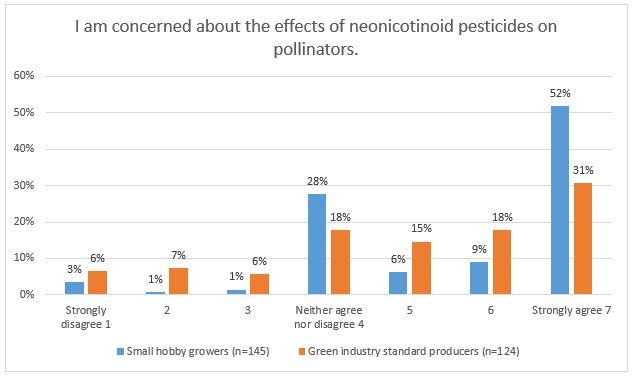
As expected, producers (in general) were less supportive of a policy requiring mandatory labeling of neonicotinoids when compared to consumers; 37% of the Green Industry standard producers selected the option of "strongly disagree," and only 15% selected "strongly agree" with the mandatory labeling of neonicotinoids (Figure 6). While consumers had a mean rating score of nearly 6, the average rating among the Green Industry standard producer participants was merely 3.2 (Figure 7).
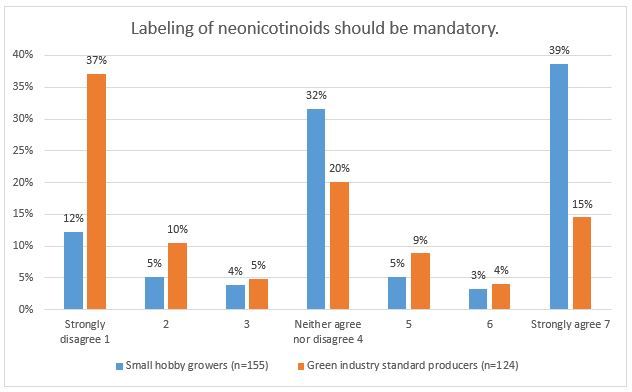
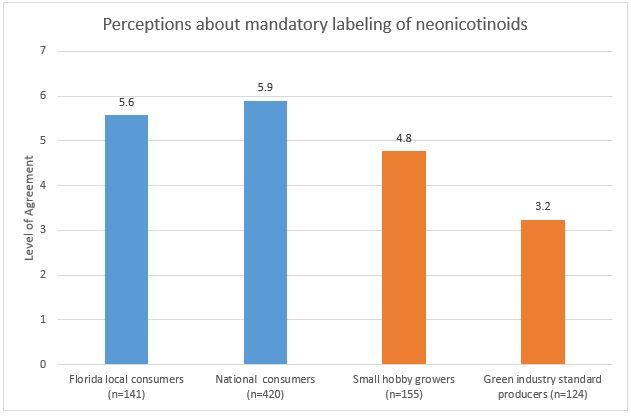
Conclusion
There is an ongoing debate about the effects of neonicotinoid insecticide-related regulations and labeling practices on market demand in the Green Industry. Our consumer survey suggested that participants tend to be more concerned about the effects of neonicotinoids on pollinators and more supportive to mandatory labeling of neonicotinoids. On the producer side, while we did see increased recognition of the potential impact of neonicotinoids on pollinators, producers showed less support of mandatory labeling of neonicotinoids. This was particularly true for Green Industry standard producers. Small hobby growers showed more concern about the effects of neonicotinoids on pollinators. A cross comparison between producers' and consumers' perceptions revealed that producer and consumer preferences for labeling pollinator-friendly attributes were somewhat different. Our results provide important feedback to firms, industry stakeholders and policy makers in the Green Industry and can effectively bridge the informational gap between producers and consumers.
References
Goulson, D. 2013. "An Overview of the Environmental Risks Posed by Neonicotinoid Insecticides." Journal of Applied Ecology 50: 977–987.
Goulson, D., E. Nicholls, C. Botías, and E.L. Rotheray. 2015. "Bee Declines Driven by Combined Stress from Parasites, Pesticides, and Lack of Flowers." Science 347 (6229): 1435.
Khachatryan, H., B. Campbell, C. Hall, B. Behe, C. Yue, and J. Dennis. 2014. "The Effects of Individual Environmental Concerns and Willingness to Pay for Sustainable Plant Attributes." HortScience 49 (1): 69–75.
Khachatryan, H., A. Rihn, B. Campbell, C. Yue, C. Hall, and B. Behe. 2017. "Visual Attention to Eco-Labels Predicts Consumer Preferences for Pollinator Friendly Plants." Sustainability 9 (10): 1743–1756.
Pisa, L. W., V. Amaral-Rogers, L. P. Belzunces, J. M. Bonmatin, C. A. Downs, D. Goulson, D. P. Kreutzweiser, C. Krupke, M. Liess, M. McField, C. A. Morrissey, D. A. Noome, J. Settele, N. Simon-Delso, J. D. Stark, J. P. Van der Sluijs, H. Van Dyck, and M. Wiemers. 2015. "Effects of Neonicotinoids and Fipronil on Non-target Invertebrates." Environmental Science and Pollution Research 22 (1): 68–102.
Rihn, A., and H. Khachatryan. 2016. "Does Consumer Awareness of Neonicotinoid Insecticides Influence Their Preferences for Plants?" HortScience 51: 388–393.
Sanchez-Bayo, F., and K. Goka. 2014. "Pesticide Residues and Bees—A Risk Assessment." PLoS ONE 9 (4): 1–16.
van der Sluijs, J. P., N. Simon-Delso, D. Goulson, L. Maxim, J. M. Bonmatin, and L. P. Belzunces. 2013. "Neonicotinoids, Bee Disorders and the Sustainability of Pollinator Services." Current Opinion in Environmental Sustainability 5 (3–4): 293–305.
Wollaeger, H. M., K. L. Getter, and B. K. Behe. 2015. "Consumer Preferences for Traditional, Neonicotinoid-Free, Bee-Friendly, or Biological Control Pest Management Practices on Floriculture Crops." HortScience 50 (2015): 721–732.
Yue, C., B. Campbell, C. Hall, B. Behe, J. Dennis, and H. Khachatryan. 2016. "Consumer Preference for Sustainable Attributes in Plants: Evidence from Experimental Auctions." Agribusiness 32 (2): 222–235.
Yue, C., C. R. Hall, B. K. Behe, B. L. Campbell, J. H. Dennis, and R. G. Lopez. 2010. "Are Consumers Willing to Pay More for Biodegradable Containers Than for Plastic Ones? Evidence from Hypothetical Conjoint Analysis and Nonhypothetical Experimental Auctions." 42 (04): 757–772.



